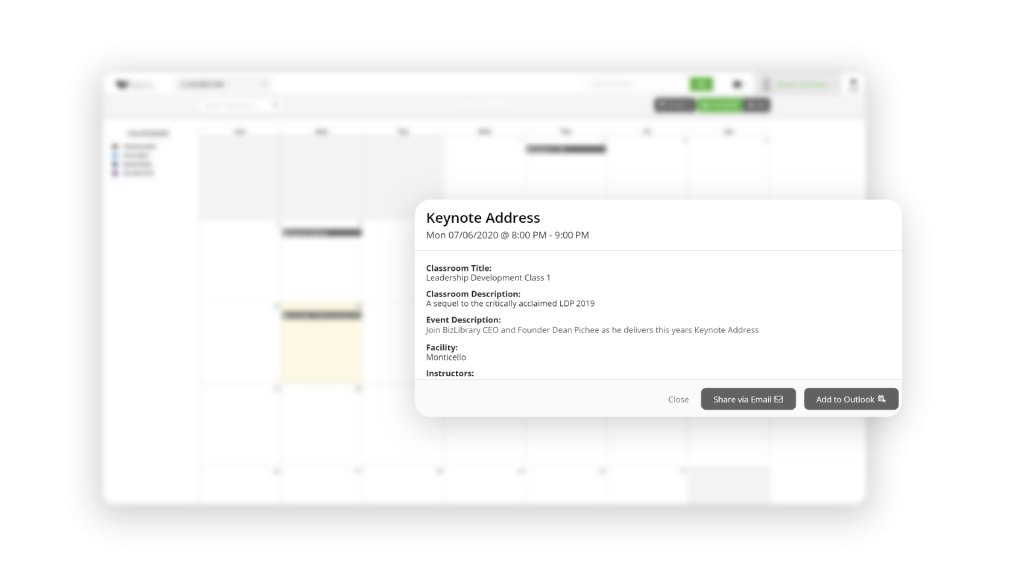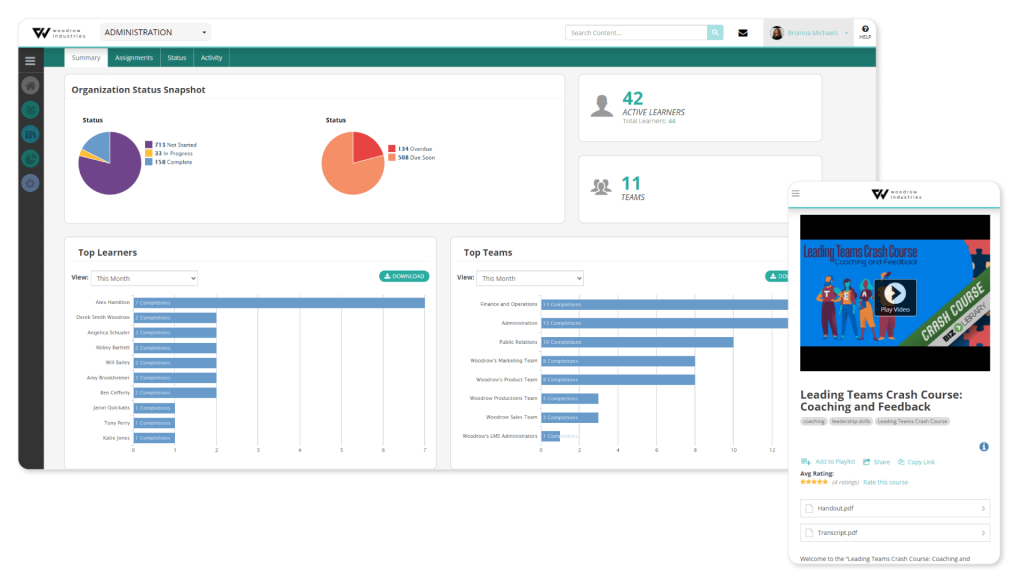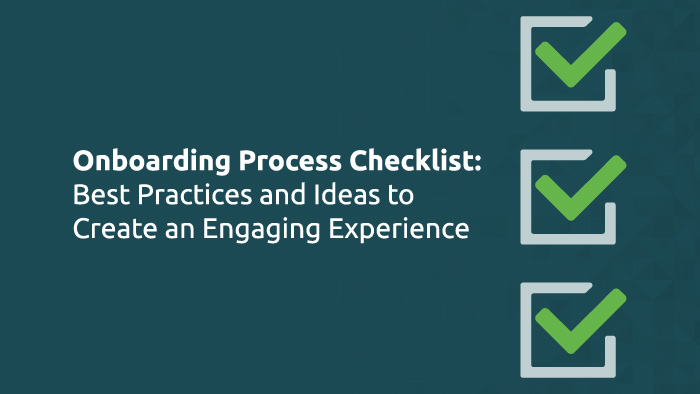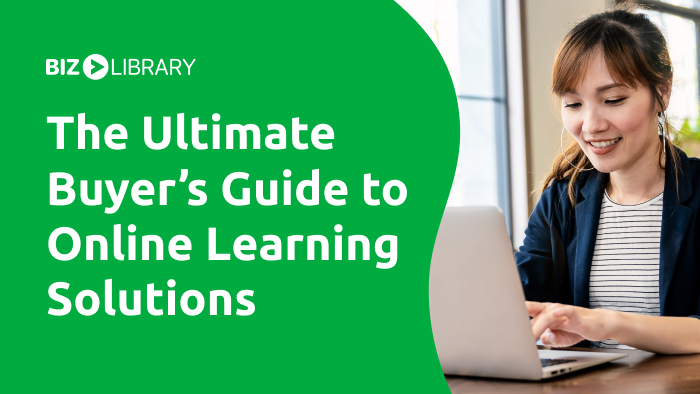We know that as a learning and development professional, you’re constantly looking for the most effective strategies to train and develop your employees, and promote learning at work.
Finding the right type of training for your company can seem daunting but understanding how to blend a few different delivery methods can really give you that boost in training effectiveness and ROI that you’re looking to achieve.
What is Blended Learning?
Blended learning is an approach learning and development professionals can take to conduct onboarding and training. This approach takes training out of solely being in the classroom to using a blend of multiple delivery methods of training employees. More than one delivery method is used because no one solution can be a good fit for every training need.
Blended learning can be delivered by different forms of instructor-led training (ILT) and online learning methods that suit each employee.
Instructor-led Training Methods
Classroom: This traditional workplace learning method mirrors a school setting. It requires a learner and a teacher to physically be present in a classroom, actively listening and participating.
On-the-Job Training: This is training that takes place within the employee’s normal job environment. It is a hands-on method of teaching new skills and knowledge needed for employees to perform their job. The employee will practice the knowledge and skills they’re learning during the training.
Mentoring: A mentorship program consists of semi-structured guidance where one person shares their knowledge, skills, and experience to assist others to progress their own career. These programs should be created situationally so that they truly benefit each employee involved.
Seminars: A small group that comes together for recurring meetings to learn about a given topic. All members of the group are expected to participate.
Conferences: A larger gathering of people who meet in a certain place at, or over a certain period of time to discuss and learn a topic of common interest. This is especially popular among distributed workforces that use this as an opportunity to have all their employees in one location for learning. A conference can also be a great way for those in a certain industry or profession to come together with like-minded professionals to advance their careers.
Online Training Methods
Video Lessons: This is most commonly a microlearning video that averages between five to seven minutes in length and is best utilized for quick, actionable learning. These lessons play like a YouTube video and will often have a quiz at the end. This type of training can be assigned, or discovered by employees within a curated content library for on-demand learning.
Video Courses: This refers to a collection of video lessons bundled together where each lesson has a quiz and there is a final exam at the end of the course. This format requires more time dedicated to learning but often works best for complex topics that require a deeper dive into the material.
Interactive Video: Interactive video lessons typically feature several prompts throughout the video that learners must complete before the course continues. This technique keeps the learner engaged throughout the learning content and can allow them to expand the learning experience with supplemental links, polls, multiple-choice questions, and more.
Elearning Modules: These are traditional, click-to-advance training sessions that often range from 15-60 minutes in length. This format often includes audio over a slide-like presentation and might include quiz questions to complete the training.
Virtual Classroom: Virtual classrooms allow the learner and trainer to communicate and collaborate by using online breakout rooms, virtual whiteboards, and screen sharing capabilities. Training administrators can integrate virtual classroom software with their learning management system for seamless tracking.
Benefits of Blended Learning
Blended training comes with many advantages over using a single method approach, as it provides your employees and your L&D team with choices and flexibility, along with other benefits.
Engaging and Appealing
Blended learning can be more engaging and appealing when it’s tailored to each employee’s needs and interests. Using a mixture of the in-person and online forms of training listed above, you can create a training program that is sure to capture the attention and engagement of any learner.
Accommodates All Employees
A blended learning plan can accommodate all your employees’ training needs, whether they’re in an office, on the floor, out in the field, or working from home. There is a format that suits everyone’s situation and learning preferences.
Maximizes Time for Training
With a blend that includes online learning methods instead of exclusively relying on in-person training, your employees have more flexibility to fit time for learning at work into their busy work schedules. With an online training assignment, an employee can complete the training whenever works best for them, while taking minimal time away from working on their regular tasks.
Saves Money
In-person training costs can really add up. It requires a space to host the training, the trainer themselves (plus their travel and accommodation expenses), and sometimes extra costs and time to get all employees to the same location. Online training saves organizations on all those expenses and allows in-person training to be reserved for when it’s truly necessary.
More Ways to Gather Training Data and Insight
An online platform can help track both classroom and virtual learning data, and provides tons of reporting and insight into the effectiveness of your organization’s training and development efforts.
If your goal is to make training much more than tracking attendance and utilization, an online platform will help you measure and analyze employee learning in so many useful ways.
For a better idea of which data makes the most sense for you to be tracking, take a minute and view our infographic on KPIs for Every Stage of Your Training Program.
A blended approach to learning can be created by combining the best of both worlds of ILT and online learning. The most important part is ensuring you’re providing the right method of training for the learner as well as the knowledge or skill they are trying to learn.
Best Practices for Using a Blended Learning Approach
Here are some considerations and steps to take when implementing blended learning in your organization:
Survey Your Employees
The first step to successfully create a blended learning program is figuring out how comfortable your employees are with different methods of learning, which methods they would prefer, and what they need to learn or improve upon.
Determine the Best Approach for Each Component
Compare the knowledge and skills employees need to learn with the delivery methods that work best for the employees and the organization.
Combine ILT and Online Content for More Impact
The different methods of training employees you use should complement one another. One common way to do this is to use online learning to reinforce what was taught as part of an ILT session. The online follow-up can reiterate main points and test the employee’s knowledge of what they learned in the class, which will greatly improve how much of the information they retain.
Another popular method is a flipped classroom, where employees are assigned online content, and then come together afterwards to discuss it – having been primed for the discussion with the online content, they’re better able to engage with and retain the learning.
Gather Feedback
Using multiple forms of training creates more opportunities to gather feedback. Asking for feedback from your employees can help you make ongoing improvements to your training program. Keep in mind that generally speaking, employees prefer to give feedback anonymously.
Feedback can be in the form of comments and ratings left on online training resources, follow up surveys for specific courses of ILT training, or overarching surveys on what employees thought of past training and would like to see in the future. Gathering feedback should be an ongoing effort to ensure training improves and is effective.
Ways to Add Blended Learning to Employee Onboarding
Research by Glassdoor found that organizations with a strong onboarding process improve new hire retention by 82% and productivity by over 70%. Onboarding is a great place to start implementing blended learning, since new hires require a lot of training, and having them sit through classroom or elearning sessions for hours is not a great experience.
Instead of making your newly hired employees sit through a day of boring slideshows or videos about your company’s history, culture, and executives; or worse, not orienting them at all, why not deeply immerse them in the culture by using an in-depth onboarding program?
At BizLibrary, our onboarding program is a blended learning extravaganza! Make your onboarding process exciting by mixing elements of games, panel discussions, independent work time, and departmental presentations (which can all be done in the office or virtually).
Engage Employees With Gamification
Playing a game related to your organization’s core values is a fun way of introducing them and making them more memorable. For example, we start off onboarding by introducing our value “Smarter Every Day” and having new hires learn a few things about each other.
This can be done with games like “Two Truths and a Lie,” where a person makes three statements- two which are truthful and one that’s a lie- and the other participants guess which statement was a lie, or “Three About Me,” where people show three things from their office that describe who they are and share them with the group. This is a great way to start the week off, so new hires can get to know one another!
Introduce Leaders Through Panel Discussions
A great way to introduce new hires to your leadership team is inviting executives and new employees to a meeting, whether it’s in person or on Zoom, and giving the new employees a chance to ask questions, as well as hear about the executive’s role and their journey that got them there. This helps new employees get to know their leaders on a more personal level and start building trust in them.
Encourage Peer-to-Peer Interaction
Either during onboarding or when your new hires start their role-specific training, have them schedule time to talk to their new team members. During these 15–30-minute individual meetings with each team member, the new hire can learn about their peer’s role and how they might work together. Then have the more senior employees share with the new hire how they got to where they are within the company.
Utilize Online Training from the Start
Build time in the onboarding schedule for new hires to use and get familiar with your online learning platform, either for independent training assignments, to encourage exploratory learning, or both!
Onboarding doesn’t begin and end on the first day of a new job. It starts with your hiring process and ends when new hires are settled into their role.
View our Onboarding Process Checklist for best practices and ideas to create an engaging experience for new employees.
Using an Online Platform to Centralize Blended Learning
With the right online learning platform, you can bring content, assignments, scheduling, reporting, and more all under one roof to make facilitating your blended learning program simple and streamlined. Your online platform can be used to introduce new methods of training, while helping you keep better track of in-person training as well. BizLibrary’s learning platforms are designed to do just this – here are some of the features you’ll find useful for an impactful blended learning program.
Instructor-Led Training Management
Managing classroom schedules, attendance, instructors, facilities, and resources is no easy task! Streamline classroom training, scheduling, and coordination all while keeping it tied to your learners’ overall transcript records with BizLibrary’s Classroom feature!

Social Learning
Our online content is designed with peer-to-peer interaction at the forefront of the learning experience. The BizLibrary Collection is loaded with social features, such as:
- Ratings: Learners can give a rating to any lesson or course, and see how others have rated it
- Comments: Along with a rating, learners can share comments and thoughts on lessons and courses
- Sorting Content: When searching for content, learners can sort by highest rated or most popular
- Sharing Videos: When learners find an especially interesting lesson, they can easily share videos with colleagues through multiple channels
- Sharing Playlists: Learners and admins can create and share playlists of content with individuals or teams within the platform
Learning Initiatives
Learning Initiatives allow training administrators to easily build and manage curriculums, whether for new hire onboarding, diversity and inclusion initiatives, new manager development, specific skills like coaching, annual compliance, or any other type of ongoing training relevant to your organization. These initiatives can automatically reset upon expiration or even be tied to employees’ training qualifications for seamless recordkeeping and management from one place.
Learning Analytics
Training administrators can easily utilize our pre-built reports and dashboards for a quick snapshot or deeper analysis of the most pertinent KPIs to your program. With Learning Insights, you can compare internal team performance, and the performance of your organization against benchmarks to see how you stack up.

Cohort-Based Learning
Cohort-based learning is a way for a group of learners to move through a course or series of courses together often online or in a hybrid environment. It often contains collaborative elements such as group coaching sessions, live discussions, and feedback sharing.
Our newest product, BizAcademy, helps develop leaders at every level. From high-potentials to the executive suite, leaders can learn with their peers in either a 4- or 16-week sessions led by experts in their fields such as leadership author Kevin Eikenberry and change champion Meridith Elliott Powell.
Learners in these sessions will get the expertise and skills they need to inspire their direct reports, excel as a leader at any level, and drive a culture of growth and development at their organization.
For these reasons and more, L&D professionals love partnering with BizLibrary to create high-performing blended learning programs. Learn more about why organizations like yours are choosing BizLibrary’s solutions for training.
Whatever challenges your company is facing, a complete online learning solution can help you design and implement a plan to overcome them.
Traditional in-person training methods are not enough anymore – a modern, online learning solution is a must-have for organizations to be competitive today. We’ve put together a guide that will show you how to evaluate learning solutions based on the quality of their content, comprehensiveness of their online platform, and whether they’ll be a strong partner for your organization.



